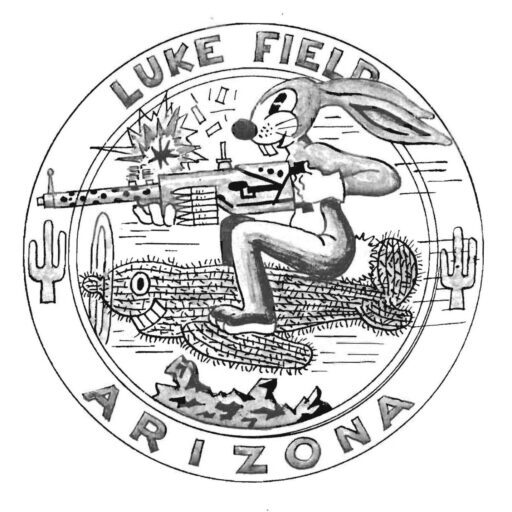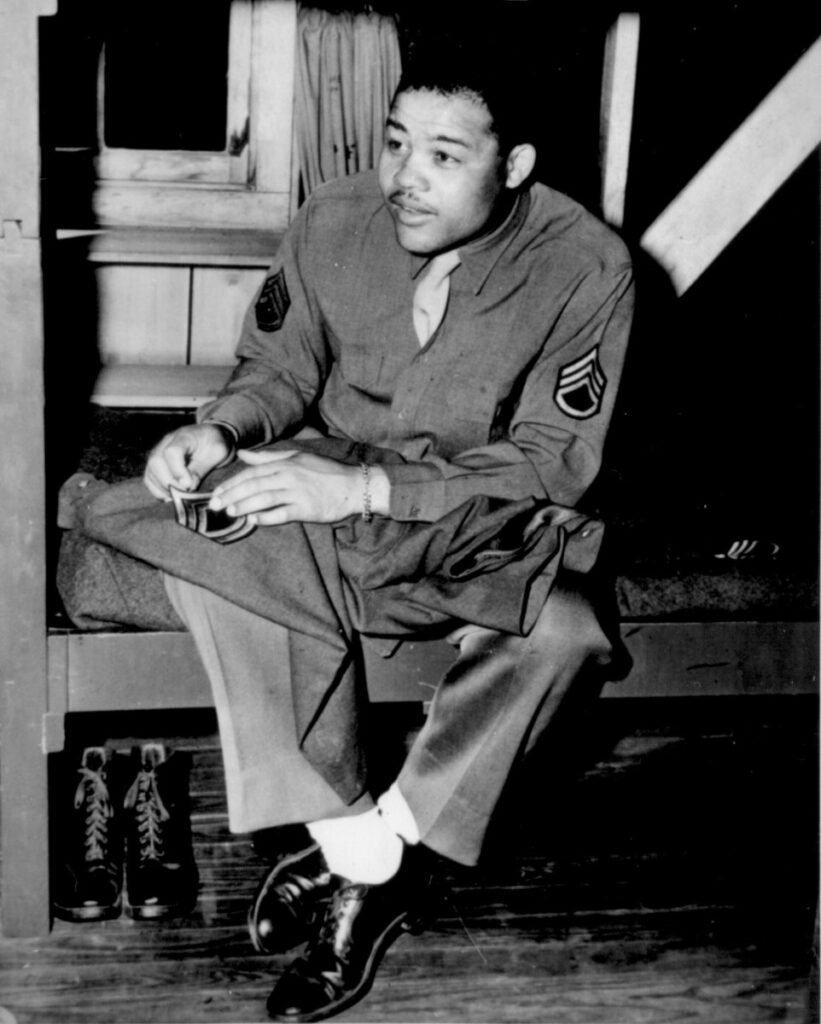To honor the men and women who flew and trained at Luke Field, Arizona, during World War II.
Notable People at Luke Field
Brig. Gen. Charles “Chuck” Yeager
Maj. Richard I. Bong
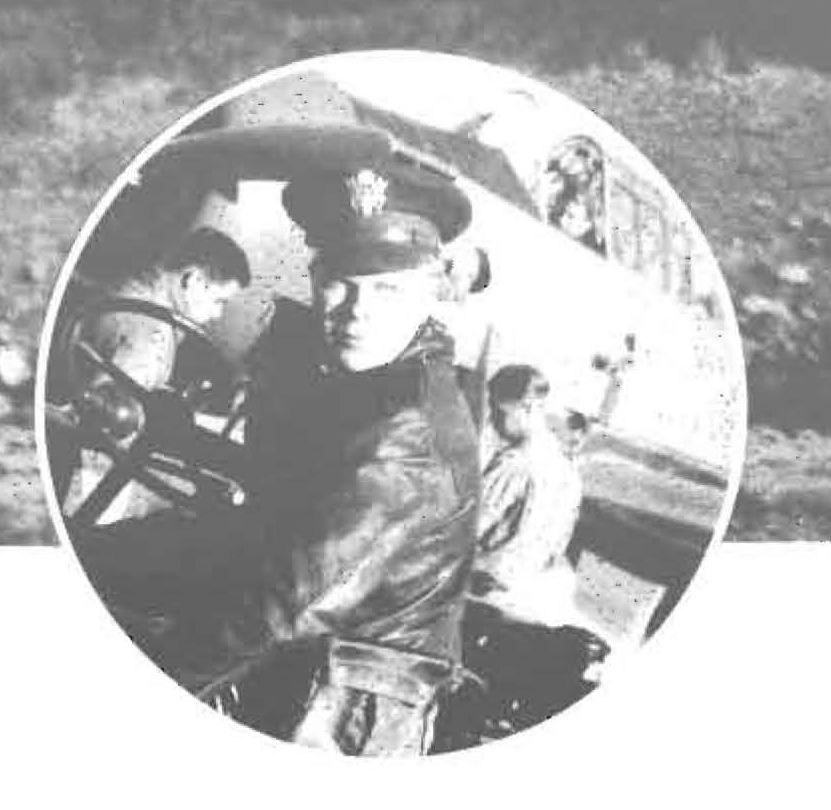
Richard I. Bong graduated from Luke Field in Class 42-A. Photo is of him as an instructor at Luke Field in the Class 42-D’s Class Book. He went on to fly Lockheed P-38 Lightning aircraft in the Pacific. He became America’s Ace of Aces by tallying 40 confirmed aerial victories, which earned him the Congressional Medal of Honor. Unfortunately, Major Bong was killed days before the end of the war, while testing a Lockheed P-80 Shooting Star jet fighter. (Luke Field Photographic Section)
Maj. John Louis Jerstad
John Louis Jerstad graduated from Luke Field in Class 42-B. He went to Europe as a B-24 pilot with the 93rd Bombardment Group. In May 1943, Major Jerstad was reassigned to Headquarters 2nd Bombardment Wing. Although he completed all of his required missions for his tour, he volunteered for a risky mission. That mission was the first major bombing raid on the Axis oil refineries at Ploesti, Romania, on August 1, 1943. Due to his actions that day, he was awarded the Congressional Medal of Honor posthumously. Part of the citation reads, “Three miles from the target his airplane was hit, badly damaged, and set on fire. Ignoring the fact that he was flying over a field suitable for a forced landing, he kept on course. After the bombs were released on the target, the fire in his ship became so intense as to make further progress impossible and he crashed into the target area. By his voluntary acceptance of a mission he knew was extremely hazardous, and his acceptance of an intrepid course of action at the risk of life over and above the call of duty, Major. Jerstad set an example of heroism which will be an inspiration to the Armed Forces of the United States.” (U.S. Air Force photo)
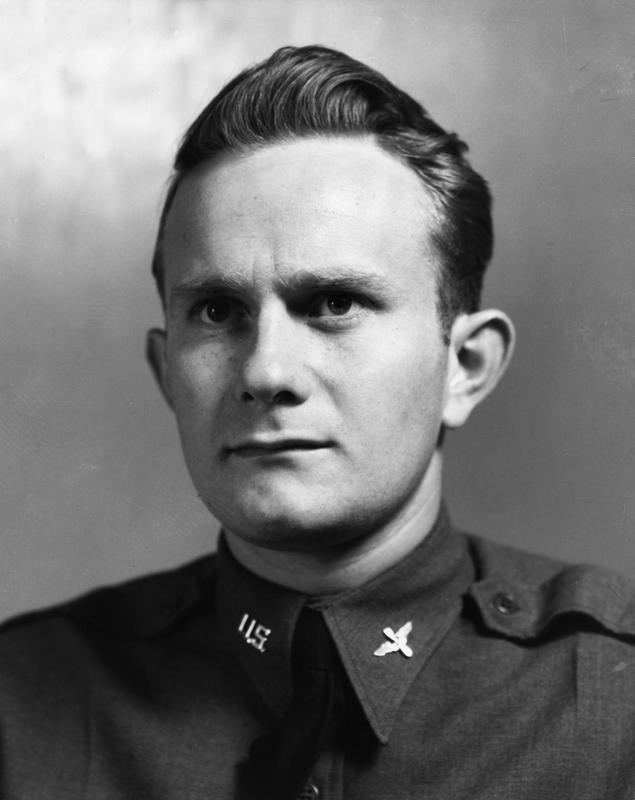
Barry M. Goldwater
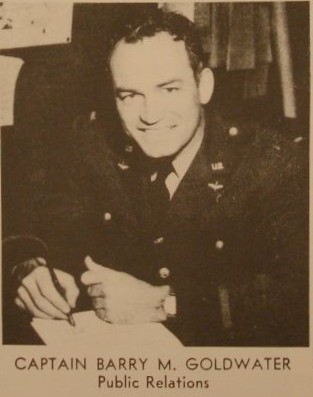
Born in Phoenix, Barry Morris Goldwater worked in his family department store before WWII. After the attack on Pearl Harbor, Goldwater received a reserve commission in the U.S. Army Air Force. After his training, one of his first assignments was to Luke Field as an instructor. At Luke Field, he taught the Chinese students ground school and later worked in the base’s Public Relations Office. In mid-1942, Goldwater was assigned to Ferry Command, which ferried various aircraft around the world. Some of those routes included flying the Hump between India and China. After the war, he went into local politics, but stayed in the reserves. In 1946, Goldwater founded the Arizona Air National Guard, which flew out of Luke Field until at least 1951. He went on to become a long-time senator from Arizona and in 1964, ran for President as the Republican nominee. He also stayed in the Arizona Air National Guard, retiring in 1967, as a major general. Photo from (U.S. Air Force Photo)
Brig. Gen. Charles “Chuck” Yeager
Charles Elwood “Chuck” Yeager graduated from Luke Field in Class 43-C. On September 13, 1941, he enlisted in the US Army Air Corps as a Private. He trained and worked as an aircraft mechanic until he entered enlisted pilot training. He graduated as a Flight Officer in March 1943. He went to Europe and joined the 363rd Fighter Squadron flying North American P-51 Mustang aircraft. He ended up with 11.5 kills during the war, including five in one day. After the war, Yeager became a test pilot at Edwards Air Force Base, California. On October 14, 1947, Yeager became the first man to break the sound barrier in level flight. He did it by flying the rocket engine–powered Bell X-1 aircraft at Mach 1.05. Photo from Luke Field Class 43-A Class Book. (Luke Field Photographic Section)
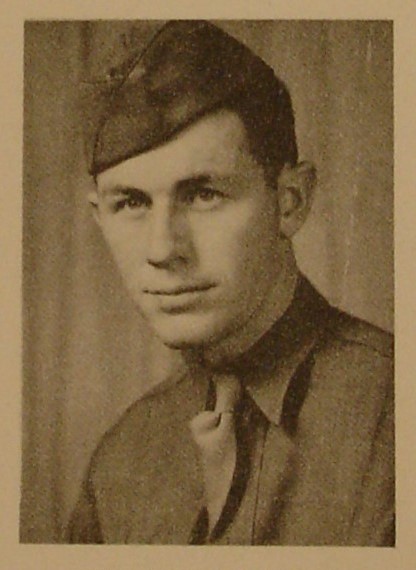
Gene Autry
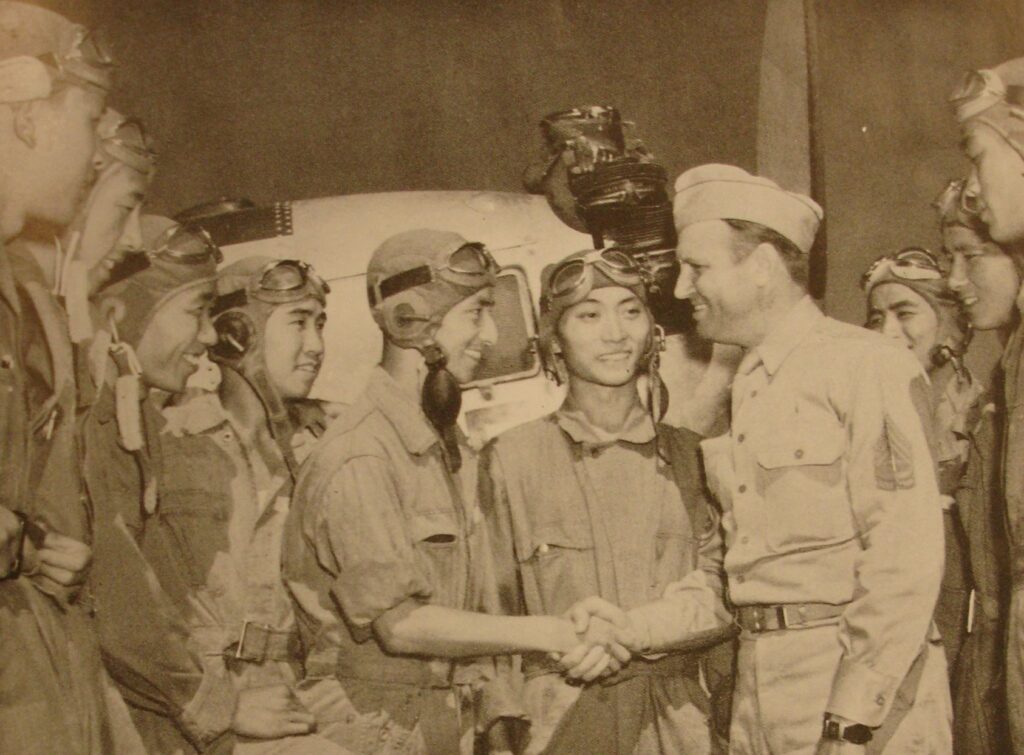
In 1942, Orvon Grover “Gene” Autry was in the middle of an extremely successful radio, recording, and movie career. The fact that he held a private pilot’s certificate along with the war effort caused him to decide to enlist. On July 26, 1942, Autry enlisted in the Army Air Corps for the duration of the war as a Technical Sergeant. Part of his enlistment agreement required him to continue his weekly radio show, Gene Autry’s Melody Ranch, for one year. During his service, he changed the shows name to Sergeant Gene Autry. After basic, he first served at Luke Field, Thunderbird Field, and then Phoenix Airport, all in the Phoenix area. During that time, he used various facilities on Luke Field to do his radio show. One of those locations is now known as the Chapel on the Mall. Sergeant Autry finally got to go to pilot training and became a Flight Officer and flew various types of military cargo aircraft for the rest of the war. Later, he bought the Anaheim Angels. (Photo courtesy The Autry Foundation and Autry Qualified Interest Trust)
Tom Poston
On November 3, 1943, Thomas Gordon “Tom” Poston graduated from Luke Field with his wings and a commission. During the war, he flew cargo aircraft missions in the Mediterranean and European Theaters, including dropping airborne paratroops behind enemy lines on D-Day. After the war, he went into acting and comedy. In 1950, he started in television. Two years later, he acted in his first movie. Despite his 16 movies, he really made his mark in television. For four years, he was on the Steve Allen Show 44 times. Between 1959 and 1967, Poston was a panelist on To Tell the Truth 317 times. He was in five episodes of The Bob Newhart Show, and five years later played George Utley, the maintenance/handyman of a Vermont inn on the show Newhart for 184 episodes. In between those two shows, he played Franklin Bickley on the Mork & Mindy for 54 episodes. In 2001, Poston married his fourth wife, Suzanne Pleshette. They first met in 1959, doing a play in New York. She also played Bob Newhart’s wife, Emily Hartley on The Bob Newhart Show for 154 episodes and made a cameo in the last scene of the show Newhart. Photo from Luke Field Class 43-J Class Book. (Luke Field Photographic Section)
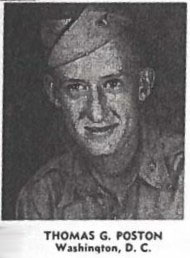
Col. Ennis C. Whitehead

Ennis C. Whitehead was the father of Luke Field. He arrived in Phoenix, Arizona, in February 1941. His job was to find a site for an Advanced Flying Training Base in the Salt River Valley and start an Advanced Flying Training School at that location.
Born in Westphalia, Kansas on September 3, 1895, Whitehead entered the US Army as an aviation cadet in the summer of 1917, after the US entered World War I. During that war, he was the Assistant Chief of Test Pilots, 3rd Aviation Instruction Center at Issoudon, France. By the end of the war, Issoudon was the largest pilot training base in the world with 13 fields in operation. One of its main uses was to train US pilots by transitioning them into the planes used in the frontline units and on current combat tactics.
After World War I, Whitehead graduated from the University of Kansas and served in a series of Army aviation jobs and attending Army schools on Engineering, the Tactical School and Command and General Staff School. Between June 1931 and November 1932, he commanded the 36th Pursuit Squadron at Selfridge Field, Michigan, as captain. From September 12, 1938 to February 8, 1941, he served on the War Department’s General Staff and was promoted to colonel.
When he arrived in Phoenix, he helped pick the final location for the air field, a mixture of farmland and desert scrub. He led the effort to have the field built, hiring the Del Webb Construction Company. He started organization the Advanced Flying Training School at Thunderbird Field No.1, moving it to National Guard Armory shortly thereafter. On June 7, 1941, the first class, 41-F, began training in the AT-6 Texan. On July 15, 1941, he moved the school to the partially completed Luke Field. As Del Webb completed buildings, base functions were moved into them in a hop -scotch pattern. In 1942, Whitehead’s Headquarters Building was one of the last of the initial build to be completed. Early in 1942, he oversaw the establishment of the Chinese Air Force Advanced Training at Luke as well as the start of the transition training to the P-40 Warhawk. He supervised the training of all of the classes through Class 42-G.
On June 16, 1942, Whitehead was promoted to brigadier general and shortly after departed to the Pacific. Where he worked for and later replaced Lt. Gen. George C. Kenney as the Commanding General of Fifth Air Force.
After the war, Whitehead commanded the Far Eastern Air Forces, the Continental Air Command, and the Air Defense Command. On July 31, 1951, he retired after 34 years of service. He died on October 12, 1964. (Luke Field Photographic Section)
Col. John K. Nissley
If General Whitehead was the father of Luke Field, Col. John Kraybill Nissley was the face of Luke Field during World War II. All told, he commanded Luke Field for 19 1/2 months, longer than any other World War II commander.
Colonel Nissley was the fourth and sixth commanding officer of Luke Field. Born in Abilene, Kansas, on January 17, 1894. He graduated from Guthrie High School in Guthrie, Oklahoma. After the US entered World War I, he joined the Army on July 2, 1917. On September 22, 1917, he graduated from Army aviation ground-school at the University of Texas. Between January and June 1918, he took primary aviation training at Foggia, Italy. His commander was Capt. Fiorello LaGuardia. LaGuardia later became the long-time mayor of New York City. Unfortunately, Foggia’s aircraft were so different from those used on the Western Front, few graduates saw action. After training, Nissley was assigned to the Staff Squadron, 3rd Aviation Instruction Center at Issoudon, France. By the end of the war, Issoudon was the largest pilot training base in the world with 13 fields in operation. One of its main uses was to train US pilots by transitioning them into the planes used in the frontline units and on current combat tactics. On May 26, 1919, he received his discharge.
At an unknown date, he rejoined the Army. In October 1922, Nissley commanded the 513th Observation Squadron in Los Angeles, California. On January 30, 1923, the unit moved to Stockton, California. He left the squadron about that time. In 1925, he was stationed at Mitchel Field, Long Island, New York. On July 25, 1925, he survived the crash of his Martin NBS-1 at Camp Vail, New Jersey. His last known pre-World War II service was between May 24 and August 25, 1931. During that time, he commanded the 76th Service Squadron in the 20th Pursuit Group at Rockwell Field, California. Between April 15, 1942 and March 1943, Col Nissley commanded the Chico Army Flying School at Chico Army Air Field in California.
On March 19, 1943, he took command at Luke Field for the first time. On July 28, 1944, he left and in September was the post commander for the Overseas Replacement Depot in Greensboro, North Carolina. On October 5, 1944, he returned to Luke Field. He departed for the last time on 9 January 1945. Between March and July 1945, he served at the commander of Langley Field, Virginia. He then commanded the Big Spring Bombardier School in Big Spring, Texas. In 1946, he retired from the service. On February 4, 1956, Col Nissley died at the Luke AFB Hospital and is buried in the Greenwood Memory Lawn Cemetery in Phoenix, Arizona. (Luke Field Photographic Section)
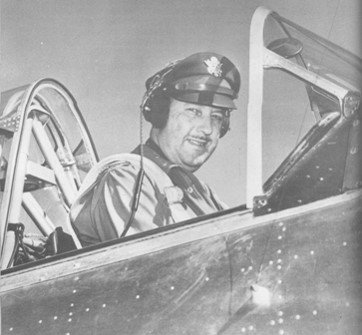
The Flying McConnell Brothers (Class 43-A)
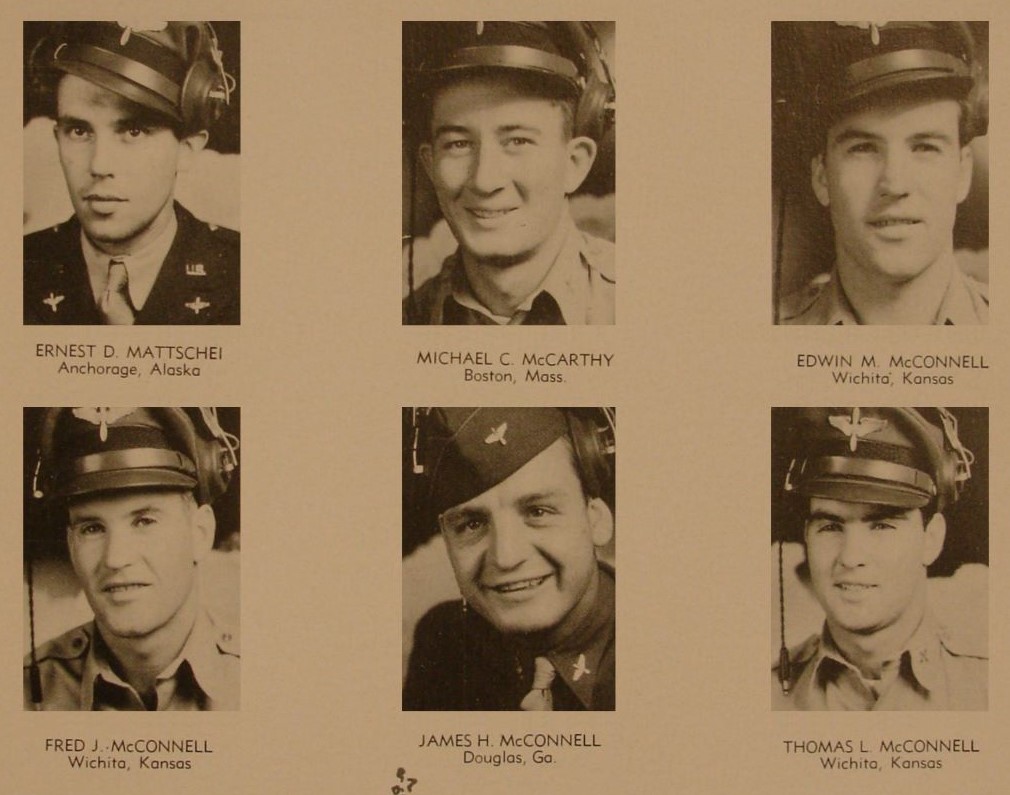
Interestingly, on January 4, 1943, Class 43-A had four cadets with the last name of McConnell. Three of them were brothers from Wichita, Kansas. They were Edwin M., Fred J., and Thomas L. McConnell. The press referred to them as the Flying McConnell Brothers. On March 22, 1942, all three brothers enlisted at Marshall Field, Fort Riley , Kansas. On April 22, 1942, all three were called to active duty and sent to Santa Ana, California, for Primary Flight Training. They went to Merced Army Flying School, California, for Basic Flight Training. Then they went to Luke Field. After graduation, they went to learn to fly the Consolidated B-24 Liberator at Alamogordo Army Air Field in Alamogordo, New Mexico, followed by Clovis Army Air Base, New Mexico, and then Topeka Army Air Field. Their last stateside station together was Hamilton Army Air Field, California. From there, they all joined the 424th Bombardment Squadron, 307th Bombardment Group, 13th Air Force Bomber Command on Guadalcanal. On July 10, 1943, all three brothers were on a mission to bomb a Japanese Airdrome. The weather was sloppy and coming off the target, 2nd Lt. Thomas McConnell’s B-24 crashed into the side of a mountain, killing all on board.
By the end of the war, Fred McConnell flew 61 combat missions. Shortly after the war, on October 25, 1945, Capt. Fred McConnell was flying his private plane when it crashed near Garden Plains, Kansas.
On May 15, 1954, due to their exploits, the US Air Force renamed Wichita Air Force Base as McConnell Air Force Base in honor of both 2nd Lt. Thomas Laverne McConnell and Capt. Fred J. McConnell.
(Luke Field Photographic Section)
Hope and Crosby
As Luke Field continued to grow in size, it began to receive United Service Organizations (USO) shows. Captured in the Class Book for Class 43-B was one of those shows. Without a doubt, the headliners were entertainers Bing Crosby (center) and Bob Hope (right). I have yet to identify the pilot. The two were in the middle of their highly successful Road picture series, having done one a year for the past three years. Hope came up through vaudeville as a dancer and later a comedian. He did Broadway productions, radio, and movies. Crosby was a singer who did radio, recordings, and later movies. Both were well established by the time they visited Luke Field. They both continued to have long careers, in movies and television. Hope was known for going on 57 USO tours to entertain the troops, most of those trips were over the Christmas holidays. (Luke Field Photographic Section)
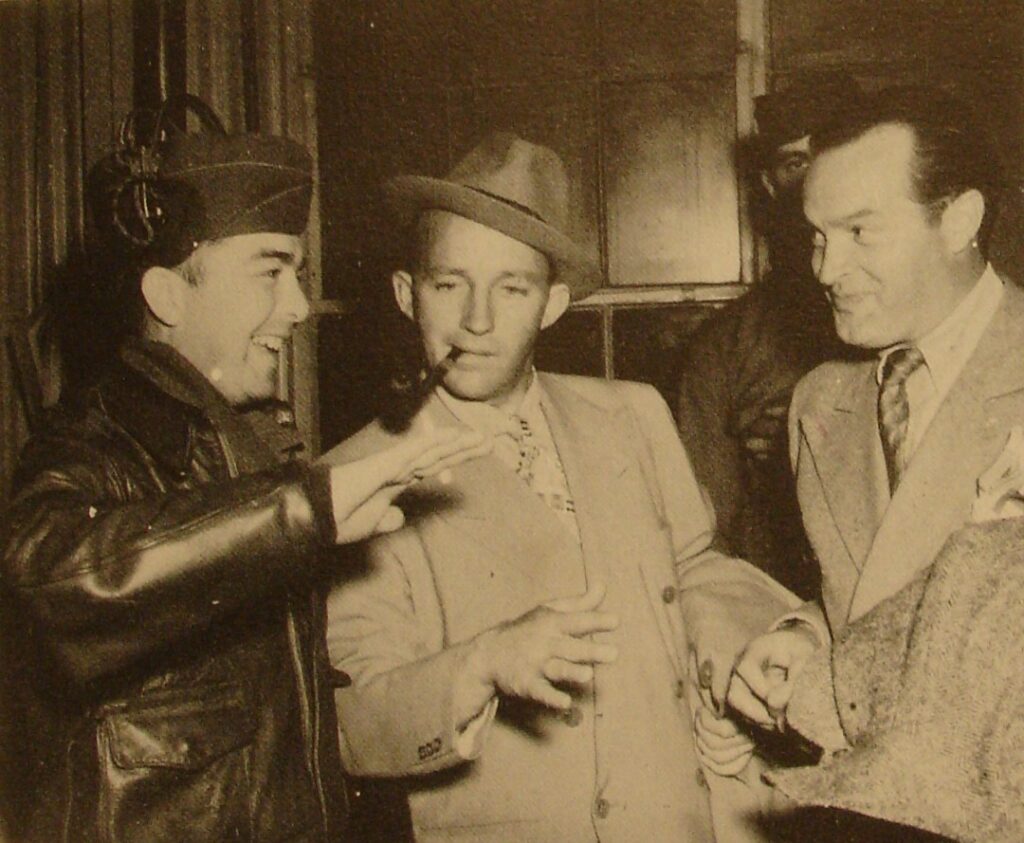
Joe Louis
During World War II, the Army was segregated by race, primarily white and black. Therefore, Luke Field was segregated. At the beginning of World War II, Joseph Lewis Barrow (left) was the Heavyweight Boxing Champion of the World. In 1937, he fought his way to the title. He became a household name the following year, when he defeated the racist Hitler’s chosen champion, Max Schmeling. On January 10, 1942, he enlisted the Army. Initially, assigned to a segregated cavalry unit, but due to his celerity, the Army later assigned him to a Special Services Division to raise esprit de corps. As such, he took part in celebrity tours around the Army. One of those stops was at Luke Field on an unknown date. To celebrate the occasion, ten cooks of the 975th (right) at Luke Field baked two cakes in his honor. Lewis continued to defend his title until he temporarily retired in 1949. ((left) US Army Photo) ((right) Luke Field Photographic Section)
